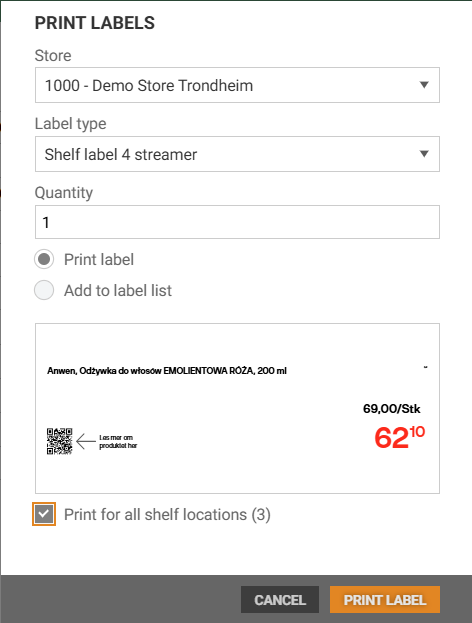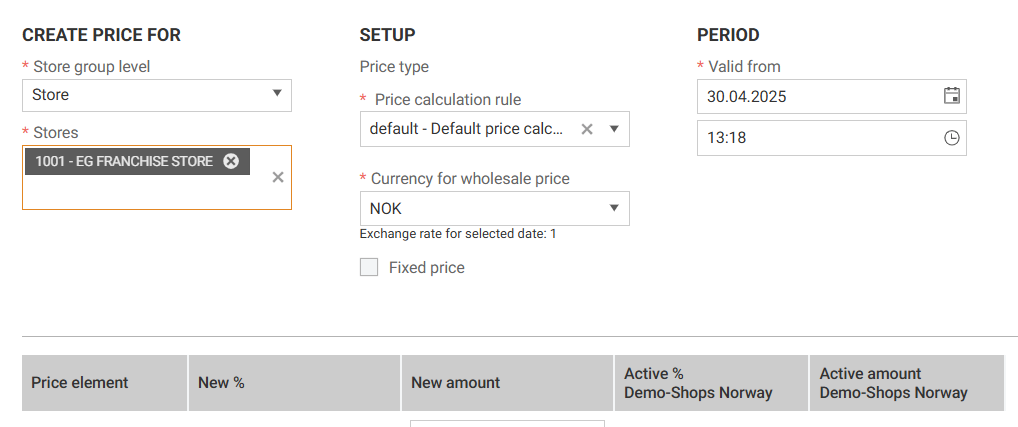Released 22 October 2025
Updated Add panel and edit modal for ingredients (RTC-47024)
Before selecting an item, the Add ingredient panel now displays only the search field.
After selecting an item, the panel adjusts automatically based on the item:
For not an ingredient item: user can define base ingredient (Base ingredient name, Quantity per unit, Number of units and Total fields are visible)
For items already marked as ingredients: user can define ingredients by adding Ingredient name, Net and Gross quantity (Base ingredient is defined for selected item and Base ingredient name field is read-only).
Similarly, the Edit modal (visible after clicking edit icon that appears on the ingredient row on hover) now shows the ingredient name, along with net and gross quantity details.
Import RIGAL - SAP ruleset logic extended with Self-service weights (RTC-48754)
When importing new items with the SAP ruleset, the system automatically sets the 'Self-service weights' flag to True if the item’s GTIN is a PLU (shorter than 8 digits), and the item has 'Open Price' set to False. Otherwise, default of values from the file will be set as value of the 'Self-service weights' flag.
Price import - Fix: Price is created instead updated (RTC-53628)
During price import, existing store prices update correctly when the RecommendedRetailPrice is not in the contract or is empty. When the imported price differs in value from the existing one, a new price is created if the price is active, or the existing price is updated if it is planned.
Fix: All food views should be displayed based on user's preferred content language (RTC-52226)
All views related to convenience food now support displaying localized text based on the user's preferred content language.
Fix: Incorrect label trigger reason (RTC-53449)
Label printing uses the correct trigger reason when a price changes. For both future and active prices, the trigger “price increase” or “price decrease” is applied based on the price change and remains linked to the label even if the item details change later.
Released 15 October 2025
Base ingredient label in Manage item texts view (RTC-52998)
In the “Manage ingredients” view, under “Manage item texts”, the base ingredient row is always listed first and has "Base ingredient" label.
Base ingredient in Excel import and export (RTC-50661)
Enhancements have been made to the Excel export and import functionality and ingredient data handling. Necessary fields have been added to both the Excel file and the export view, allowing users to export complete ingredient data.
Users can now edit values directly within the fields; however, values cannot be removed to maintain data integrity.
Additionally, validations have been introduced to ensure that quantity per unit, net quantity, and number of units must be greater than zero.
Base ingredient cannot be removed (RTC-50752)
The application has been updated to ensure that base (default) ingredients cannot be removed. The delete option is now disabled for all base ingredients.
Fix: Base ingredient name not updating immediately after changing it using Manage item text
When a base ingredient name is modified via the “Manage Item text” page in “Manage ingredients” view (Ingredients grid) updated base ingredient name is correctly saved and reflected immediately in item details convenience section.
Store prices - Remove price calculation register (RTC-50108)
Price calculation register is removed. It is not visible in the registers grid. In all places, where it was possible to choose one of price calculation rulesets, now there is only one available. All prices that exist and are created, have one price calculation ruleset.
Store prices - Fix: Setting validTo date when deleting price (RTC-53470)
When a price in the middle of a price sequence is deleted, the validToUtc date of the first price updates to match the validFromUtc date of the next price. This keeps the price timeline continuous and ensures correct price validity periods in the store.
Fix: Not able to remove Supplier from item (RTC-53339)
It is possible to add, remove and edit suppliers on item on all store group levels.
RIGAL import - Fix: Store group in filename is not mapped to store group (RTC-52961)
When in the filename the last 4 last digits are external store group number, they are correctly mapped to store group. No matter if in the file there is an empty value of other value for external store group number, it is correctly mapped to the one from file name.
Fix: Some items are excluded from import (RTC-53547)
All rows from imported files appear correctly in the import view. This ensures that every item from files with multiple rows is included and visible in the system during import.
Released 9 October 2025
Store Prices - Fix: ValidTo handler in BackgroundWorkers with exception (RTP-42948)
BackgroundWorkers job is running without exception and ValidTo date is set on prices.
Released 8 October 2025
Fix: Update of promotion is slow (RTC-50855)
Updating promotions that include many items runs faster. The store price grid loads quicker and avoids timeouts. Filtering within the grid also responds faster, improving overall efficiency when managing prices.
Store prices - ValidTo in ItemPrice export (RTC-51188)
ValidTo date of prices is exported in ItemPrice blob. When the first price is created for an item - store group, only that price is exported. If a previous price already exists, the export includes both the updated old price (with a modified ValidTo date) and the new price. When exporting an item from the item grid, all active and planned prices for that item are exported.
LIP 4 - Lip jobs status (RTC-53039)
Status 'CompletedWithWarnings' is correctly displayed after job execution.
Store Prices - Fix: ValidToHandleris too slow (RTP-42826)
Performance of ValidTo handler in BackgroundWorkers job has been improved.
Released 3 October 2025
Import of items and prices - Fix: Performance of StagingBatchExecutor (RTC-53273)
Import of small files such as Item.Item or ItenmPrice with singular row is faster. Even when there is a lot of data in the PricatImport.Import table, StagingBatchExecutor is working without queueing.
Released 2 October 2025
Fix: Item Search when there is no item related data in elastic (RTC-53249)
Documents without item related data in elastic are filtered out in search. Searching for items in modals is possible (as long as they are active in at least one store) without errors.
Fix: Null reference in StagingBatchExecutor (RTC-53250)
When ItemPrice blob is imported, there is no error in StagingBatchExecutor and price can be imported.
Released 30 September 2025
Item search based on new index (RTC-44522)
Item search shows only items that are active in at least one store. This applies to all functionalities using item search, such as substitution items, deposit items, bundles, and related items. The same happens in item search in main item grid. The search compares the entered text with item text in the same language as the user’s content language. In the item search modal, a message explains that only items active in at least one store are visible.
Store Prices - ValidTo set on all existing prices (RTC-48715)
ValidTo handler was added to BackgroundWorkers job. This handler gradually updates validTo date on all existing prices, except for the last active price in each store group. When all updates are complete, the job finishes without further action.
Item area access in user interface (RTC-49309)
Users with limited area access only see and work with the item groups and actions they are allowed to use. When creating or updating an item, the item group dropdown shows only the groups the user has access to. In the item group hierarchy, users only see the parent departments, groups, and subgroups that belong to their access areas. In Label Printing, users can only view and print labels that match their access rights. This ensures that users only manage items and labels within their allowed areas.
Promotion price Label on non-promotion price mixes (RTC-53015)
When there is a promotion on mix e.g. 21, we don't display value on the PromotionPrice from promotion service for item that are non promotion price mixes.
Assignment of default shelf location based on Phase in date (RTC-48055)
A parameter to configure how many days before the Phase In date the default shelf location should be automatically assigned to an item has been added. Scheduled integration job has been added to run every night at 00:49. This job will retrieve the store local values for items where the Phase In date is within 14 days of the current date. For each item/store, the default shelf location will be resolved based on the department and the shelf area linked to that department. If the shelf location does not already exist, it will be created. The shelf location creation logic will use the first shelf type from the register.
Manage item texts for ingredients (RTC-50825)
A new "Manage Item Texts" feature has been introduced in the Manage ingredients view (user can enter the view by clicking on “Item name” hyperlink in the Ingredients grid) to enhance multilingual support.

Users can now manage ingredient names in multiple supported languages via two access points: a button in each row of the ingredient grid and a global button at the bottom of the view.
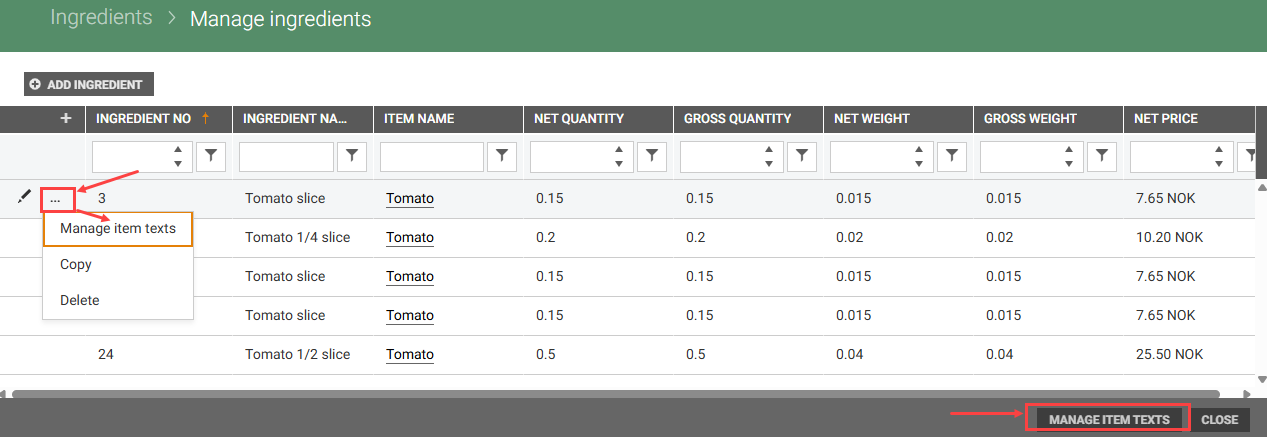
Clicking the row-level button opens a pop-up allowing users to edit or add names for the selected ingredient, with validation ensuring at least one language field is filled. If all fields are empty, a red error message appears below the section: "EN: Text in at least one language is required."
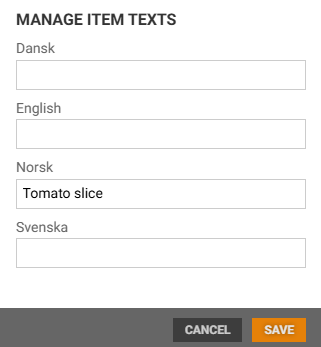
The bottom-screen button enables bulk editing of names for all ingredients linked to the currently managed item or base ingredient. Each ingredient is clearly labeled and the same validation applies.
If no language text is provided for any ingredient, a red error message appears above the save button: "EN: Text in at least one language is required for each ingredient."
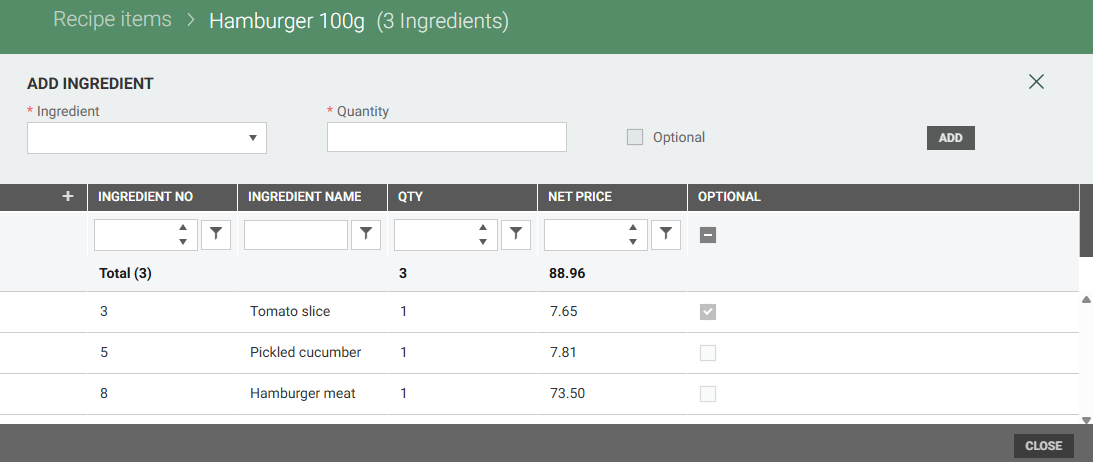
Break down base items for ingredients (RTC-50658)
When the “Ingredient item” flag is selected, the form now displays options to create a New ingredient or select an Alternative item, along with fields for base ingredient name, quantity per unit, number of units (defaulting to 1), and a calculated total.
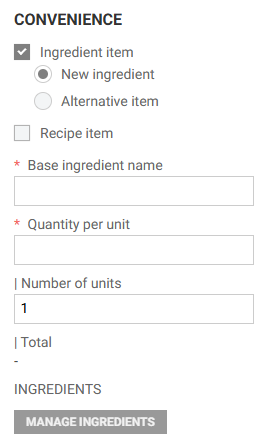
If the item is not yet an ingredient, users can choose to create a New ingredient (with NetQuantity and GrossQuantity set to 1) or Select an existing base ingredient from a combo box. The total is automatically recalculated as quantity per unit times number of units.
After saving, the base ingredient name and selection options become read-only, while quantity and units remain editable. All fields include standard validations, ensuring base ingredient names are valid and quantities are greater than zero.
Improved Edit recipe user interface (RTC-52250)
The 'Total' label has been relocated to the “Ingredient No.” column, and the entire Total row now features a light gray background, matching the filter row styling. Additionally, the text within the Total row has been enhanced with bold formatting and a darker font color for improved visibility.
A new feature has also been added to display the count of ingredient rows in the grid, providing users with a quick summary of the total number of ingredients listed.
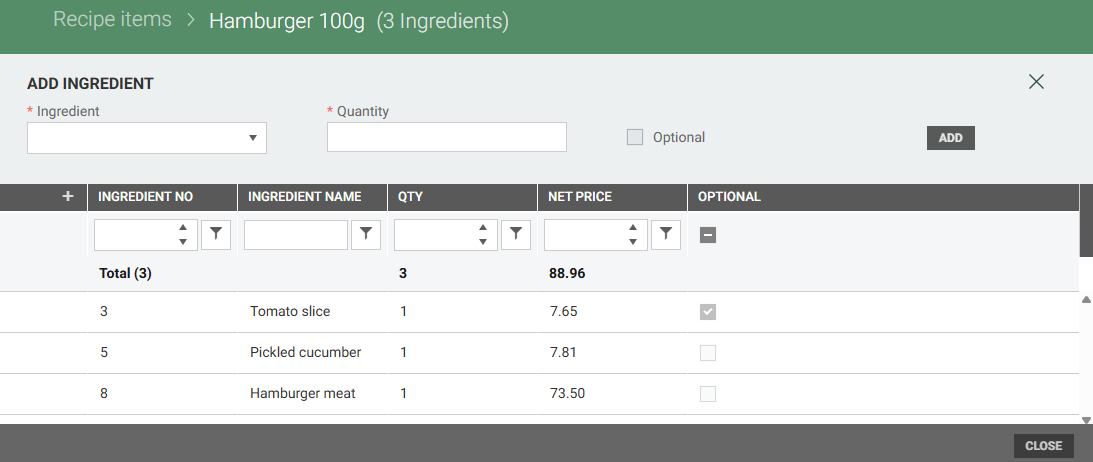
Convenience database changes (RTC-52274)
This release introduces key enhancements across the database, import/export processes, and core functions.
A new IngredientAlternativeItem table has been added, along with updates to the Ingredient table (new IsDefault field) and the Item table (new IngredientInfoAmount and IngredientInfoQuantity fields).
A data converter has been implemented to support migration for IngredientAlternativeItem. The ingredient import/export logic has been refined, specifically within Gateway.ItemChanges and the ‘yieldsIngredients’ section.
Additionally, functions for suggested recipe price calculation and active store price checks for ingredients have been updated to align with the new data structure.
Base ingredient fields JSON Import (RTC-50660)
Validation logic has been introduced for importing the fields “Quantity per Unit” and “Number of Units” from JSON. These fields will now be processed only if the current item is marked as an Ingredient (IsIngredient = True). Additionally, the imported values for ‘quantityPerUnit’ and ‘numberOfUnits’ must be greater than zero. If these conditions are not met—such as when the item is not an ingredient or the values are invalid—an appropriate error message will be returned.
Base ingredient fields JSON Export (RTC-50659)
A new enhancement has been implemented to ensure that whenever the fields “Quantity per Unit” and/or “Number of Units” are added or updated, a corresponding JSON payload is automatically generated. This payload captures the latest values of these fields.
Fix: User with Manage store local values permission can export file (RTC-52941)
Users with the View/Manage storeLocalAttributes permission can export items to Excel. Clicking the Export to Excel button creates and downloads the file without errors or missing responses.
Fix for: Offer label text fixes (PriceSign A4) (RTC-51907)
Mix offer label text for label type PriceSign A4 is displayed in the correct format when printing the label in Label printing.


User interface for Excel export (RTC-50201)
In user interface for Excel export there is new selectable section 'Store group fields' where user can select store group level and store groups to export attributes for. When checked, the export adds columns for store group identifier and name. These columns stay in the export and cannot be removed. In Export user interface there is additional column “Store group attributes” containing level and name of store group, while the attributes stay in the same columns as common values in item details. Only one section can be exported at a time: prices, store local fields, store group fields.
User with limited access - Item area access in Import (RTC-51887)
During import, items are filtered by the user’s area access. A new item can only be created in an item group the user has access to (item group belongs to area in users area access). When updating items, the user must have access to both the current group and the target group if the group is being changed. Rows for items outside the user’s access are marked with validation errors, preventing unauthorized changes.
IngredientInfo in Gateway.ItemChanges contract (RTC-51237)
This release extends the existing Gateway.ItemChanges contract to include base ingredient information (IngredientInfo), enhancing ingredient tracking and consistency.
Additionally, the export contract has been updated to include the number of portions per unit and the number of units.
Released 29 September 2025
Fix: Label list printing timeouts (RTP-42521)
SQL query optimized to ensure label printing is faster and completes without timeouts.
Released 18 September 2025
Fix: Label list printing timeouts (RTP-42334)
SQL query optimized to ensure label printing is faster and completes without timeouts.
Released 10 September 2025
Fix: Timeout in label printing grid (RTC-52735)
Filtering in the Label Printing view works faster and avoids timeouts. This applies when a user has access to only one store, as well as when filtering by store and adding more filters.
Released 1 September 2025
Fix: Support for 429 errors (RTC-49987)
The export process to Elastic handles 429 "Too Many Requests" errors automatically. When large exports run, the system retries based on the guidance returned from Elastic. This prevents failed exports caused by temporary overloads and ensures that all data is sent successfully.
Fix: For format of boolean values in ItemPlanningAtributes (RTP-41699)
Boolean values in ItemPlanningAttributes within the Item contract are exported as True or False. Importing assortment code per profile triggers GenericExport job and exports item and store group local attributes.
Released 20 August 2025
User with limited access - Item area access (RTC-50195)
Lists, details, and related views only show items from areas a user can access. Actions such as view, edit, export, and import apply only to these items. Users can import an item from outside their access area, but it will not appear to them after creation. The system blocks visibility and changes to items outside the user’s area, including for price suggestions, labels, store assortments, price control, ingredients, recipes, and menu items.
Support pagination in item search (RTC-48405)
The item search results now display up to 24 items per page with additional results available through pagination. Users can browse beyond the first 100 items by navigating through the pages.
When a request contains the SearchAfter field in its body, a sorting option must be provided. If sorting is omitted, the system now returns an error with HTTP status code 422 and the message "Unprocessable Entity".
Assortment code (RTC-50413)
The assortment code for an item is stored in the item.item table when no assortment per profile is set. When assortment per profile is used, the code is stored in StoreGroupLocalAttributes. Existing data is migrated automatically, and any existing assortment codes are kept. In exports, the assortment code appears in the same way as before but comes from its updated storage location. If no item planning exists but an assortment code is set in StoreGroupLocalAttributes, a placeholder item planning is created so the code is still included in exports. When assortment codes per planning are enabled, in Excel and in the user interface, assortment codes from all store groups are always visible. Otherwise, the item’s assortment code is displayed.
Store user in Price control grids (RTC-49621)
When price suggestions exist for only one of the store groups user has access to, the store group panel stays open by default. It shows the store group level and store group details. Users can close the panel, leaving only a button visible. This makes it clear which store group the suggestions belong to while still allowing the panel to be hidden if needed.
Generating labels with offer mix types text (RTC-48245)
Label Processor creates labels for active mix promotions.
Labels are created when a promotion includes a LabelOfferText or is promotionPrice.
A change in LabelOfferText triggers a new label.
Promotions with promotionPrice are always used over other mix types.
If multiple promotionPrice offers exist, the label uses the one with the lowest price.
For offers with LabelOfferText, the label uses the offer that ends first.
If multiple valid offers exist in the same promotion, the one with the highest offer ID is used.
Fix: No 'Copy of' prefix when making a copy of an item (RTC-50352)
The text “copy of” has been removed from the modal displayed when copying an item. The item name comes from the copied item.
Fix: Incorrect breadcrumbs when returning to the Ingredients page (RTC-51796)
Resolved an issue where the breadcrumb trail incorrectly retained the "Manage Ingredient" label after navigating back from the Manage Ingredient page to the Ingredients grid.
The breadcrumb now correctly resets to display only "Ingredients" upon returning to the Ingredients grid.
Menu item cannot be an ingredient (RTC-50971)
On Ingredient page, validation has been added to “Add ingredient panel”, to prevent creating ingredients from menu items.
When searching for menu item, a red message now appears under search field stating "Menu item cannot be an ingredient". Ingredient cannot be added if the currently selected item is menu item.
Fix: Valid from set to 0001-01-01 when no date in import (RTC-51000)
When in import of ItemPrice, there is no field 'fromDate' or it is set to null, imported items are saved in database and shown in user interface in details of the import with ‘validFrom’ date null or empty accordingly. After importing such import items, price is set to today's (current) date.
Export allergens (RTC-51643)
A new export functionality has been introduced, including the creation of a dedicated Blob Storage for allergen data exports. The export contract has been published, enabling seamless data sharing with third-party systems in JSON format.
Additionally, this export type has been integrated into the Export view, allowing users to manually trigger the export process as needed.
Export nutrition data (RTC-51642)
A new export feature has been implemented to support Nutrition data sharing. This includes the creation of a dedicated Blob Storage for managing exports, the publication of a formal contract for third-party integration, and the ability to export data in JSON format.
Additionally, this export type has been added to the Export view, allowing users to manually trigger the export process as needed.
Fix: Item text is exported in default country's language (RTC-52212)
Item text in main fields (Model Name, Item Text, Label Texts, Receipt Text) for item with data in several languages are exported in the default country’s language. If the default language is not available, the export uses another available language.
Tenant navigation - Fix: Console error when user has access to only one tenant (RTC-51708)
When a user has access to only one tenant, the dropdown menu does not appear, and no console errors occur when opening grids. If a user can access more than one tenant, all available tenants appear in the dropdown list for easy switching.
New field in GetItemStoreAvailability API (RTC-48997)
“LastReplenishedDateUtc” field is now included in GetItemStoreAvailability API response.
New column “LastReplenishedDateUtc” (UTC datetime format) in [Item].[ItemStock] table.
Type Item.ItemStockType updated to include LastReplenishedDateUtc.
Modified stored procedure: [Item].[UpsertItemStockStatus] to handle upsert logic for LastReplenishedDateUtc.
Item Search API - Fix: Request fails when retrieving only facets (RTC-52366)
When using the Search API with top=0, the request returns only facets without errors. This makes it possible to fetch facet information without retrieving items.
Released 5 August 2025
User import works without store data (RTC-51598)
Users with roles scoped to selected stores import successfully even if the file does not include store information. Roles are assigned based on teams and profiles without causing errors.
Local Item flag (RTC-48862)
The Local Item flag (also called "Managed by Store") can be imported and exported using both Excel and JSON. It is not possible to set both "Local Item" and "Managed by HQ" to True at the same time. This rule also applies during import. If both flags are True - either in the import file or already on the item - a validation error explains that only one of them can be True.
Mark Items as spare parts (RTC-51285)
In the “Related items” section in Item details, items can be marked as Spare part by selecting a checkbox. This helps users clearly identify which items are spare parts. By default, items are not marked as spare parts.
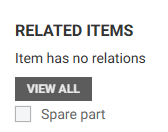
Spare part field in JSON and Excel imports (RTC-51283)
The ‘isSparePart’ flag is now supported for import through both JSON and Excel files. This enhancement allows users to update the flag using JSON and Excel files.
Spare part field in JSON and Excel exports (RTC-51284)
The IsSparePart field is now included in both JSON and Excel exports. This enhancement ensures that spare part identification data is consistently available across exported formats, improving data portability and integration with external systems.
Elastic - Update 'ItemPartialSearchView' view (RTC-51286)
The “ItemPartialSearchView” has been updated to ensure that the value of 'IsSparePart' is now calculated directly from the 'IsSparePart' column in the Item.Item table.
The multicountry text is shown in the user's content preferred language (RTC-50812)
Multicountry text in Item Management shows in the user's content language. This applies to Items in import, items inside the import, and product information fields in Item details. If the selected language is not available, the system uses another available language instead.
When exporting items to Excel, the export language uses the user's content language rather than the country default.
Note: Unit texts in Items in import and items inside the import still use the default country language, as the register is planned for removal - RTC-45476.
Store prices use ValidTo date to maintain history (RTC-48713)
When a store price is updated through the user interface—either by creating a new price or accepting a price suggestion—the previous price ends automatically using a ValidTo date. In imports, existing prices end based on the ValidFrom date of the new price. This keeps price history accurate and avoids overlapping prices.
FIX: Offer label text (RTC-51398)
Offer label text for mix 23 & Mix 21/22 is displayed correctly on the top row. The bottom margin and the display of pennies have been moved and centered.
Label export updates when store-local values are removed (RTC-51389)
When all store-local values are removed from an article, the label updates automatically and uses the global article value. If a single store-local value is removed, only that specific value falls back to the global setting. In both cases, the correct data is exported to Pricer.
Define food items from Item details (RTC-50656)
New item type selection replacing “Food item” checkbox. Three new options have been added:
Ingredient item
Recipe Item
Menu Item
Selecting "Menu Item" will automatically hide the other two options, as it is mutually exclusive. However, "Ingredient Item" and "Recipe Item" can be selected together. Clicking Save button applies the changes.
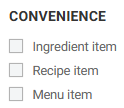
Faster navigation from Ingredient and Recipe overview (RTC-50643)
The user navigation withing ingredient and recipe management is enhanced.
In the Ingredient overview, clicking the Item name link opens the “Manage ingredients” view.
In the Recipe overview, clicking the Item name link opens the “Edit recipe” view, just like the Edit recipe button. This makes it quicker to update ingredients and recipes.
Ingredient prices and total cost stay visible in recipe view (RTC-50834)
Ingredient prices and the total cost calculation remain visible in the recipe content view, even after refreshing the page or reopening the recipe. This ensures consistent access to cost details while working with recipes.
Base ingredient in the database (RTC-47745)
New fields in Food.IngredientBaseItem table:
Quantity - Ingredient quantity per unit / net quantity
TradingUnitID - Unit
NumberOfUnits
Base ingredient name is stored in Food.IngredientBaseItemLocalizedText table. The Total (not stored in the database) is automatically calculated field based on the ingredient quantity per unit and number of units.
Export Allergens and Nutrition’s (RTC-45364)
Allergens and nutrition’s data are exported to the blob storage in JSON format, aligned with the item.changes contract. This enhancement ensures that any changes to item-level allergen or nutrition information are accurately captured.
Released 9 July 2025
Offer texts on shelf labels (RTC-46791)
Offer texts are shown on shelf labels based on the country language settings of the store group. This applies to Shelf Label 4, Shelf Label 4 Streamer, Price Sign A5, and Price Sign A4.
For shelf labels, either the offer text or the promotion price appears based on these rules:
Promotion price offers are prioritized over other mix types
If multiple promotion price offers exist, the one with the lowest price is selected
If no promotion price offers are available, the offer that ends soonest is selected
If multiple offers exist within the same promotion, the one with the highest ID is used
Multibuy offers are only shown if they include offer text. The following mix types are supported:
Mix 23: Multibuy quantity (e.g., "3 for 2")
Mix 21/22: Multibuy price (e.g., "2 for 199:-")
Only those types of mixes are supported. Example of label look:
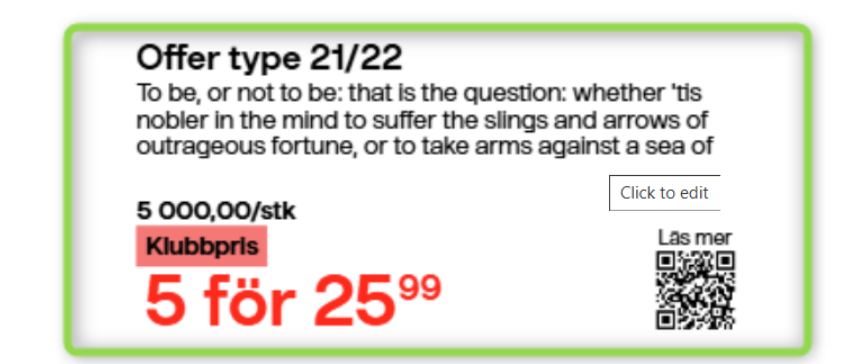
Warning when item has no text in user's preferred language (RTC-51336)
If an item has no text in the user's preferred content language, the system displays the text in another available language. This language is also used as the default when editing the item to avoid creating a new translation by accident. A warning message appears at the top of the item details page, explaining that the item has no text in the preferred language and showing which language is displayed.
Authentication setup for Pricer Plaza (RTC-49827)
Users with the right permissions can enter values for ClientId and Client Secret for Pricer Plaza in the System parameters view. A new "Pricer Plaza" section is available for this. The Client Secret is hidden in the interface to protect sensitive information.
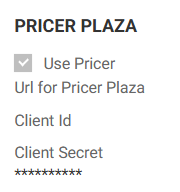
SKU prefix in Pricer label export (RTC-51395)
SKUs are exported with the prefix EG_Internal_ in the Pricer label export. This helps Pricer Plaza clearly separate SKUs from GTINs, ensuring correct identification and processing of product data.
Validation for ingredients with zero quantity (RTC-50092)
The system blocks the creation or editing of ingredients with a quantity of zero. An error message appears if a user tries to add or change an ingredient with zero quantity. This validation applies in both the Add Panel and the Edit Modal to ensure consistent and accurate data.
Suggested price calculation for Recipe Items (RTC-47298)
When creating a store price for a recipe item manually, the system suggests an initial price based on the total cost of the ingredients in that store. The calculation includes both standard and optional ingredients and uses their current store prices and quantities from the recipe. Users can adjust the suggested price freely before saving. The suggested price is only showing the current value of the recipe.
Multicountry text follows user's preferred language (RTC-42835)
Multicountry text in the Item details page, Item grid, and Variant grid is shown in the user's preferred content language. If no text exists in that language, the system displays the text in another available language instead.
The following fields do not yet follow the preferred language setting: weight declaration, product features, advertisement information, and technical information.
Multicountry support for nutrition names (RTC-49773)
The nutrition register supports names in multiple languages. The name shown in the register and item details follows the user's preferred content language. Contract item changes also support localized text for nutrition names.
Multicountry support for allergen names (RTC-49772)
The allergen register supports names in multiple languages. The name shown in the register and item details matches the user's preferred content language. Contract item changes also support localized text for allergen names.
Updated field names in recipe item Add panel (RTC-50735)
Field names in the panel for adding ingredients to a recipe are updated to make them clearer and easier to understand.
Import of allergens and nutrition for food items (RTC-50489)
Allergens and nutrition values are imported and shown in the item details. Users can add or update these values directly. Each value is linked to a unique code to ensure correct matching. A warning appears if an allergen or nutrition code does not exist.
Import of menu groups (RTC-48577)
Menu groups can be imported using the contract Item.MenuGroup.Import. A group is created if the menu group number does not exist, or updated if it already does. The menu group number is always required. The name is required only when creating a new group, unless a name already exists in at least one language.
Add-on prices are optional and only shown if included in the import. Items that are not found in the system are skipped. Menu group names support multiple languages and appear automatically in the view after import.
Import of Ingredients with fields (RTC-49043)
Ingredients can be imported with full support for all fields in the import file. The system checks the ingredient number to decide whether to create a new ingredient or update an existing one. If the ingredient number is new, a new ingredient is created using the provided data. If it already exists, the corresponding ingredient is updated. Additionally, if the number exists but the imported item is not the current base item, the system sets the imported item as the active base item and updates it.
Localized ingredient names are imported for all languages included in the file. Both net and gross quantities must be between 0 and 1. If not, a validation error appears: “Net quantity or gross quantity is not in the required range.” The system also calculates and updates the gross and net weight based on the imported values, ensuring accurate and consistent ingredient data.
New fields in search API (RTC-49398)
Added new fields to Search API /api/gateway/Search/items - 'availableInStore' and 'phaseOutDate'. Both fields can be used to search for items and are also included in API response.
Reliable export to elastic search without timeouts (RTC-50740)
Item export to Elastic Search runs without timeouts. When a store is added to a profile with many priced items, all updates complete as expected.
Released 4 June 2025
Import of teams - Fix: Do not lookup Country in StoreGroup import (RTC-50493)
When team without country is imported to Item Service, StagingBatchExecutor executes correctly and team is imported to database and has by default set countryCode as 'NO'. If later country is updated in Store Service on such team, change is also reflected in Item Service. When a team has country assigned from the beginning, correct country code is set in database when imported for the first time.
Released 2 June 2025
Price - The 'Create store price' button is available for store users (RTC-49677)
The 'Create store price' button is visible for store users with 'Create/Edit prices' permissions, as well as with 'Edit only sales prices' permission, regardless of their common level access. This means that a store user with only the common 'View items' permissions can create/ edit prices. However, to see the 'Create store price' button on an item managed by HQ, the user should have the 'Manage prices by HQ' permission.
Food items import (RTC-48551)
Importing food items via the integration import by the item contract is possible. For yieldsIngredients, the system checks for the presence of ingredientNo. If it exists, the imported item is added to the base items and marked as active. If it does not exist, the item is skipped, as unsupported ingredients are not handled at this stage. For madeOfIngredients, if ingredientNo exists, it is assigned to the recipe and its data is updated. The optional flag is treated as false by default—if not present, the ingredient is considered required. If ingredientNo does not exist, a validation warning will be triggered. For menuGroups, if menuGroupNo exists, it is assigned to the menu and updated accordingly. If it does not exist, a validation warning will be shown.
Fix for: Ingredient grid net price filtering (RTC-49899)
Filtering functionality aligns precisely with the values displayed in the user interface. Users can filter using the exact values they see and retrieve the expected rows without discrepancies.
Fix for: Ingredient grid hidden columns not supported (RTC-49962)
Created/Modified Date and Created/Modified By columns consistently reflect accurate and reliable data. These fields correctly capture the timestamp and user information associated with the creation and modification of records.
Promotion import - New offer mix types are supported (RTC-49902)
The new offer mix types (42, 46, 105) have been added to the database, in the 'Promotion.OfferMixType' table. These offer mix types are now supported in the Item management, and promotions containing these offers are imported without any exceptions or errors.
Search API - Return item hierarchy as tree (RTC-49318)
Search endpoint returns Department -> Area -> Item group facets in hierarchy. Only requests with department and brand facet are supported. When sending department facet in request, response consists of all item areas and all item groups in a bracket manner. To receive entire hierarchy, no size should be specified in request.
Release 26 May 2025
The price of a recipe item can be created only for stores and profiles for which all the ingredients of this recipe also have a price. The price cannot be created if any of the ingredients does not have a price in the given store/profile, which will be communicated to the user with the corresponding price creation. This rule also applies to optional components.
Copy regular and food items (RTC-49058)
A modal dialog is displayed when initiated copying the item from the item details view or the recipe item grid. The modal pre-fills the item text with the original item's name, allowing users to modify it as needed. By default, the GTIN field is set to "Generate GTIN," but users can enter a GTIN manually. When this option is selected, a dedicated input field becomes visible.
Create ingredient (RTC-48596)
Ingredients can only be created if the base item has an active price. Attempting to use a base item that does not have an active price will result in a corresponding message and the inability to create an ingredient.
Ingredients item - Base items for ingredients (RTC-48595)
It is possible to set an active base item for ingredient only if the base item has an active price.
Fix for: Ingredient grid improvements (RTC-48564)
The decimal fraction can be filtered for net quantity, gross quantity, net weight, gross weight, and net price in the ingredients grid. User is allowed to sort the columns and results are displayed accordingly.
'Edit item group' button (RTC-48554)
Editing item group is no longer in modal but is done in the same view as item group details.
Scoped permission - Prices for 'Managed by HQ' items are no longer editable by store users (RTC-46126)
Support for Manage prices HQ permission when creating price for an item. This permission includes both 'View prices' and 'Create new prices'. Only users with the 'Manage prices by HQ' can create and update prices for items marked with the 'Managed by HQ' flag. These users can also manage prices for common (non-HQ- managed) items. The new permission applies to both price updates via user interface and Excel imports.
Users without the 'Manage prices by HQ' permission can only view prices of HQ managed items, they cannot create or update prices for them. When such users try to update prices of a 'Managed by HQ' items vie Excel, they receive a warning "Some values cannot be updated due to insufficient permissions" and the price is not updated. However, they can still manage prices for common items, depending on their store permissions.
Import - Attributes per store group (RTC-46092)
The StoreGroupLocalAttributes contract has been extended with the 'Bonus' flag. Now, all attributes, such as 'assortmentCode', 'warrantyType', 'idRequirement', 'salesPurpose', 'specialGroup', 'isBeingPhasedOut', 'bonus' can be imported per store group using JSON Item Import. For attributes 'assortmentCode', 'warrantyType', 'idRequirement', 'salesPurpose', 'specialGroup', it is possible to import either an existig value or a new one. If a new value is provided, it will be automatically added to the system. For such attributes, 'code' is required. For the 'isBeingPhasedOut' and 'bonus', the values can be set to either true or false. To remove any value, you need to send 'null'.
Attributes per store group are exported as separated blob type,
'Item.ItemStoreGroupOverride.Export', every time when they're updated on item.
Promotion import - Localized offer text import (RTC-49529)
The localized LabelTexts are imported from Promotion in Offer contract as dictionary, where key is a languageCode and are saved in the 'Promotion.OfferTextLocalized' table in Item Management database. It is exported always in store/store group context, even for all stores for mix 21/22 when new price is set and for mix 23 when discount is equal to 100%.
Import of available in store and phase in, Phase out dates (RTC-47521)
New store local fields: Available In Store, Phase In Date and Phase Out Date can be imported on items via JSON in StoreLocalAttributes section and Store local values Excel. Values can be added, edited or deleted (except for Available in Store flag acceptiong TRUE or FALSE only). To import those values user has to have 'Manage Store Local Attributes' permission.
New fields are returned in response for request /API/gateway/Item/storeLocalValues.
Price import - Fix: File import fail, due to GTIN exists on different item in file (RTC-50003)
When uploading an excel file containing prices or other data for the same item, all rows in import are successfully validated and imported without any validation errors.
Retail price 0 is ignored in the SAP price ruleset (RTC-47847)
A retail price of 0 is automatically rejected with a warning when imported with SAP price ruleset, both during price creation and update. A correct price, when used with the same ruleset, is imported successfully.
ProfileId and PriceZoneId on Store group (RTC-47897)
The 'import of Store groups has been extended. For Profile store group a ProfileId is set, for Price zone, both a ProfileId and PriceZoneId are set, for Private group, ProfileId and PriceZoneId (if the store is part of the price zone) are set. For other store groups, these values cannot be set. The ProfileId can be changed for the price zone and the Private store groups, but it cannot be deleted. The priceZoneId can be changed or deleted only for the Private store group.
Additionally, when PriceZone is linked to the profile that doesn't exist yet in database, the profile will be added. The flow is the same way for the Private store group, if the profile/price zone does not exist in the database, they will be added.
API for import (RTC-47069)
It is possible to import items via API. It requires body of an item contract. If validation fails, user will get response with validation errors and warning. If item was imported correctly, user will get successful response with all item identifiers of the imported item. Item can be imported through api/gateway/Items endpoint.
Pull import logic into core project (RTC-47068)
Code regarding import logic has been moved to the core project. All imports are working correctly and warning and error messages are displayed as before. There is one new error: "invalid json" which is visible in the UI when imported json file is missing a field or when value is incorrect (negative value of price / minimum order point bigger than maximum).
StagingBatchExecutor: performance issues (RTC-49435)
StagingBatchExecutor job's performance has been improved and it is no longer finishing execution with status 'Faulted'.
Released 29th of April 2025
Promotion imports - Mixes on labels localization for offers (RTC-48224)
User can input values in simple fractions within both the "Add Ingredients" panel and the "Edit Ingredients" modal. Fractions are automatically converted to decimal fractions once the input field loses focus, ensuring seamless data entry. The system continues to accurately calculate gross and net weights based on these values, maintaining precise measurements throughout.
Create single item promotion (RTC-46998)
In item management, in 'Store prices' tab, when item has at least one store price, there is button 'New promotion price'. It redirects to Promotion Management new promotion page, similar to the one for 'New promotion from existing item list'. Only Promotion Price and 101 Promotion Discount price rules are available for the offer. After 'Create', draft promotion is created, and user is redirected to manage items view for newly created offer.

RIGAL import - Map item type (RTC-46510)
Item type can be imported on item via RIGAL import. Code should be located on 131 position and will be imported only if field 48 has value.
RIGAL import - Map additional fields (RTC-46492)
Sub-supplier number (field 53), Report Category Code (68), Supplier Sales End (91) and Ordering Blocked (124) are mapped to values in Item Management. When importing value that does not exist in registers, new is created, otherwise correct register is assigned to item. Supplier Sales End field expects a date in format YYYYMMDDWW. When importing row, where flag on field no. 5 is K, M or A, this row is omitted.
Item Export - Export food items (RTC-43384)
The export functionality has been enhanced to include detailed information based on food item types. Item designated as a recipe item in the recipe grid, it is exported along with the list of ingredients that the recipe contains. Item designated as an ingredient, it is exported with the list of ingredients that can be made from that item. Any changes to menu items, such as adding or removing menu groups, are reflected in the export, ensuring that the menu item is exported with the updated menu groups. Deleting food item data also deletes it in the file and therefore exports null. Changing the base item for an ingredient will export the corresponding data for the active item and null in the file for the item that was changed. Changes made to food items, such as editing an ingredient, editing a group menu, editing an item menu, editing a recipe or its contents, cause the data to be exported with the current values.
Item supplier - Crete food items (RTC-47047)
To ensure that food items have specific suppliers, the system now restricts the supplier dropdown to only food production suppliers when creating food items (recipe and menu items). If there is only one food production supplier, the dropdown will be pre-filled. If no food production suppliers are registered, users will be unable to create new items. Instead, a message will appear stating that the necessary suppliers are not available, along with an option to go to the registry.
Item copy - Fix for: Status draft not set when copying an item (RTC-48824)
Copied items have Draft status. Item price is not copied so this is the correct status for newly created items.
Convenience food items - Prevent changes on central level (RTC-47360)
Users with the "Manage Local Convenience" permission can now perform specific actions related to local recipe items. They can copy recipe items (creating them as local items), create new recipe items (also as local items), and manage the content of these local recipe items. However, they cannot update central food items, create, edit, or remove ingredients, menu groups, or menu items. Additionally, they can manage local items from the item details (convenience column). When the "Manage" permission is applied, the "View" permission will be automatically checked at the common level. The permissions granted at the common level still allow for the creation and editing of ingredients, the creation and editing of recipe items, the creation and editing of group menus and the creation and editing of item menus.
Released 9th of April 2025
Show and allow to filter on Shelf Location (RTC-48504)
A new option has been added to the "Main shelf location" column in "Label printing", allowing users to filter Shelf locations by range (from-to). It is still possible to filter the column as before, by single shelf location number.
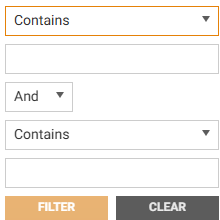
Label Layout (RTC-49013)
Layout for labels Maxi and Mini has been fixed: Maxi label has landscape orientation, Mini has portrait orientation.
Item details - Convenience columns (RTC-47231)
New buttons for managing food items: "Manage Ingredients," "Edit Recipe," and "Edit Menu item" are added. Each button navigates to a specific view where users can manage ingredients, recipes, or menus. Changes made from item details will be reflected in the respective grids. These features are filtered by convenience permissions to ensure appropriate access.
Released 8th of April 2025
Check digit control when importing GTINs (RTC-47797)
A new system parameter "Validate GTIN check digit on import" has been added. If the parameter is enabled, a digit check will be performed when importing GTINs (both main and alternative). If the Main GTIN does not pass the digit check, the import is rejected and the error "GTIN does not pass check digit control" is displayed. If the alternative GTIN does not pass, a warning "Some alternative GTINs won't be imported" is shown.
The digit check applies only to GTINs with 8 to 14 digits inclusive. The digit check is not performed if the GTIN is a PLU, starts with 20, or has more than 14 or fewer than 8 digits. These GTINs are considered valid.
If the "Validate GTIN check digit on import" is disabled, the digit check is not performed. Any GTIN can be imported, and the user can import GTINs as before.
"Managed by HQ" flag on item (RTC-48513)
A new flag, "Managed by HQ" has been added to the item column under Local item checkbox in item details and is set to false by default. This flag can be imported both via JSON and vie Excel. It is also exported to 3rd party in "Getaway.Item.Changes" blob and can be exported by the user. Only one flag can be set: either Local item or Managed by HQ, but never both.
The import and export contracts have been extended with new value in Swagger, and the Item.Model table in the database has also been extended.
Related items - New relation types (RTC-47984)
New related item types have been added: Spare, Accessory, Replacement and Included. These types can be added to item via UI in related items section. The new types are supported in JSON import and are returned in the item API (GetItem).
Available in Store, Phase in & Phase out - database + user interface (RTC-44552)
New store local attributes have been added at the store level: "Available in store" flag, "Phase in date" and "Phase out date". The attributes are independent of each other, and the user can add a column for any of these attributes in the grid or remove it. "Available in store" flag, "Phase in date" and "Phase out date" can be added to store, modified or deleted. there can be only one Phase In & Phase out date pair per item & store.
Additionally, the visual appearance of the grid for store local attributes has been updated. By default, those should be shown: store number, store name, tara, country of origin, shelf life, weight declaration, best before, self service weights, stop sale. The database has been extended with new attributes: "AvailableInStore", "PhaseInDate', "PhaseOutDate".
Price Sign A4 (RTC-47663)
Label Price Sign A4 can be assigned to items and printed. Triggers to create a new label are changes in label text, sales code and price or promotion price. Label can be printed manually from item details / item lists or added to Label list.
Characteristics of the label:
Label is a size of the entire A4 page, with label text on top and sales code beneath it. Under the sales code there is price per unit if it exists. Below, adjusted to left side is the price or promotion price. If item is in promotion in member offer, text 'Klubprice' highlighted in light red is displayed above price. Promotion and ordinary price display differs in color - red for promotion and black for ordinary.
Languages of the texts on label are based on store from which label is generated.
Add default layout for labels (RTC-47884)
Each label has its own position (landscape or portrait), and this is already set in print view.
Fix: Display data in Shelf Label 4 and Streamer (RTC-48175)
Sales unit values appear correctly on all labels, and all relevant information is displayed accurately when printing from different views. . When clicking on link generated by QR code, user is redirected to correct destination site.
Additionally, advertisement information, as well as other language-based fields are shown in the appropriate language, based on the store group’s country.
Import of item (RTC-47801)
When importing an item, it is possible to set a VAT code by providing the active rate. The import must specify a country code and either the VAT rate code or the active rate.
If a VAT code with the given rate already exists for the specified country, that code will be assigned. If no such VAT code exists, a new one will be created using the active rate as both the Code and Name. If a VAT code with that Code (e.g. 15.00) already exists in the database, a new code will be generated based on the active rate and the current date and time.
If the country code is not specified, importing using the code or active rate will default to the system's default country code.
Fix: Create price wrong time zone adjustment (RTC-48580)
Fixed formatting of ValidFrom in price calculation during price creation and update. It is possible to create prices for stores/store groups in different time zones in user interface.
Recipe items (RTC-47023)
The system supports the automatic creation of ingredients from the content of recipe items.
Users can add ingredients and any other items to recipe. This process uses an ingredient made from the item with quantities set to 1. If the ingredient does not exist, it is created automatically without user intervention. A new ingredient is created if the ingredient exists but the chosen item is inactive, users do not need to perform any actions regarding the creation or usage of ingredients, but they can see the results in the ingredient grid.
Copy recipe item (RTC-47064)
Recipe item can be copied. It contains all the data of the original item, excluding prices, GTIN is created automatically. To do this in the recipe items view, simply select the item and click the Copy button. Since copying this type of item creates a new item, this option has also been added to the item grid. It is therefore possible to copy any existing item from the item grid using the copy button hidden in the additional functions for each line. Even then, prices are not copied.
Ingredients (RTC-47818)
Gross and net weight fields are optional for ingredients. When a base item has a weight, it will be calculated automatically. If the base item does not have a weight, these fields will be grayed out, ensuring clarity and ease of use. This enhancement allows for better handling of ingredients that may be added in pieces without specific weights.
Fix for: Create new recipe item modal (RTC-47911)
The modal header for creating a new recipe item got a new correct text which is: ‘New recipe item’.
Released 18th of March 2025
Convenience column in Item details (RTC-47227)
A new "Convenience" column has been added to the Item details. The values in this column are read-only. Items are categorized based on their usage:
Ingredients display their names.
Recipe items display their assigned ingredients
Menu items show their menu groups.
If there are more than five additional details, a View all button appears. Changes in the ingredient, recipe, or menu grids update the Item details accordingly. For non-food items, a “Food item” checkbox remains unchecked and disabled.
Recipe items can also be used as ingredients, resulting in two types of food items.
Fix for: Scroll side panel in the recipe item and menu group (RTC-47952)
Scroll functionality to the side panels in both the menu group view and recipe item view is added, ensuring users can easily navigate through options when there are more items that can be displayed at once.
Item names in the Menu group are displayed in the language corresponding to the country selected as default, both in the side panel and within the group itself.
Grocery attributes on items - Export (RTC-47922)
When "Quantity in pallet" and "Genetically modified" attributes are added, updated or deleted in the item details, they are exported to 3rd parties, Getaway.ItemChanges blob. Also, user can export them by selecting in the "export to excel" view. Additionally, the export contract in Swagger has been extended with "Quantity in pallet" and "Genetically modified" attributes.
Fix: Timeout when adding missing item - store links (RTC-48288)
When adding or moving store to profile, item store links are created faster and processing many store links does not cause timeout.
Label printing timeouts (RTP-38111)
Opening Label printing view and filtering works faster and without timeouts.
Import Assortment code per price zone - contract (RTC-47803)
The contract in Swagger for import of items has been extended with 'StoreGroupLocalAttributes' with the following list of attributes: Assortment code, Warranty type, Id requirements, Sales purpose, Special group.
Manage local items permission (RTC-47359)
The "Manage Local Convenience" permission is added to the store role under items. A new "View Convenience" permission is introduced at a common level.
The existing "Convenience" permission has been renamed to "Manage Convenience", but it still controls the same actions for now.
Newly added permissions are visible in user management role user interface and can be exported and imported, but they are not yet used in the system.
Released 11th of March 2025
API for returning prices for given item (RTC-43350)
A new API request returns all undeleted prices for a given item in a store, including prices at private, price zone, and profile levels. If there are prices for the profile or price zone the store belongs to, those prices are also included in the response.
Request requirements:
The body of the request must include one item identifier - SKU, GTIN, or External Item Number and the Store Number (required).
If there is no match for sent item identifier and store number, then items are presented as empty square brackets.
When sending request with identifiers connected to different items (in one pair of the brackets), item information for all those items will be returned.
ActiveOnUtc was removed from the request.

Leading zeros are removed when importing tandem GTIN (RTC-32182)
When importing tandem GTINs via Excel or JSON, any leading zeros are removed. This applies to both tandem and main GTINs. For existing items with leading zeros in tandem GTINs, the zeros are also removed to ensure consistency.
Ingredient base items (RTC-47132)
Users can add multiple base items to an ingredient, with only one base item being active at a time while the others remain linked but inactive. A new “Active flag “has been introduced, and all previously created ingredients, as well as those created via the user interface, are set to active by default.
When the active base item is changed, all associated recipe items are automatically updated to reflect this change, ensuring consistency. Changes to inactive base items do not affect the ingredient or its recipes.
Changes applied to the backend part, without the user interface, so for now the user cannot manage the multiple base items directly from the app.
Menu items overview (RTC-35324)
The menu items grid provides a structured overview of available menus. Clicking a menu opens a side panel showing linked menu groups, each containing a dropdown list of items and their add-on prices (if given). A "Number of items" field specifies the minimum required items per group, which can be zero but never negative.
Users can create new menus but cannot delete or deactivate menu items within this grid. Deactivated items do not appear. When opening the grid, the side panel remains collapsed for the first row. Access and actions in this grid depend on Convenience permissions.
Multicountry support for ingredients name (RTC-43349)
Ingredient names now support multiple languages. In the Add panel and Edit modal, text fields are available for all system-supported languages. A name must be provided for each supported language.
The ingredient name is displayed in the language of the default country set in the registry.
Label printing view sorted by main shelf location (RTC-46885)
The label printing view includes a "Main shelf location" column, which displays the main shelf locations. This column is hidden by default and must be added manually. Changing the main shelf location does not update the already created label.
The grid is sorted by main shelf location when available; otherwise, it sorts by item group.
Shelf label 4 Streamer (RTC-45340)
Shelf label 4 Streamer can be assigned to items and printed. A new label is created when there are changes to label text, advertisement info, sales code and price or promotion price. Label can be printed manually from Item details or Item lists or added to Label list. A QR code, generated from the system parameter , is included on the label.
Label layout:
Top: Label text 1, followed by advertisement info (overlapping text is cut).
Middle: Sales code (left) and price per unit (right).
Top right corner: Main shelf location for the store.
Bottom right corner: Price, formatted according to store currency.
Highlighted yellow if the sales purpose field is filled.
Red font if the item is on Promotion without a sales purpose field.
Bottom left corner: QR code with a side arrow and instructions for scanning.
The label language is based on the store where it is generated.
Country removed from ID requirement register (RTC-46080)
The “Country” column is removed from the ID requirement register. CountryCode is now nullable in the database and no longer in export.
Released 4th of March 2025
Store group level drop-down (RTC-47955)
All store group levels are displayed correctly in the dropdown when creating or updating the price (price calculation view)
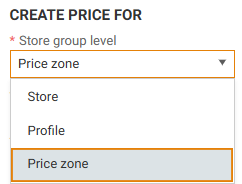
Grocery attributes on item (RTC-47486)
The item details have been updated with new attributes. A new field, 'Quantity in Pallet' has been added to the 'Package' section. Additionally, a 'Genetically Modified' flag is now available in the 'Food' section. The 'Healthy' attribute has also been moved to the 'Food' section. Those fields can be updated via UI. The database has been extended with the 'Quantity in Pallet' and 'Genetically Modified' values.
Menu groups (RTC-34698)
Menu groups is newly added feature under the Food section called "Menu Groups." This allows users to view an overview of existing menu groups in a grid format. Users can create new menu groups or update existing ones. When adding new items to a menu group, users can specify an add-on price.
Users can see a list of items within each menu group, including their GTINs. Users also have the ability to edit the add-on price of items or delete items from the menu group.
Access to the view as in all food related things is managed by the convenience permission.


Fix: StagingBatchExecutor completed with warning during promotion import (RTC-46029)
The StagingBatchExecutor job execution finishes without warning when an offer is deleted.
Additionally, in other cases, if the job completed with a warning, more information is displayed to explain what happened and how to investigate it.
Released 26th of February 2025
Edit only sales price permission, when importing prices via Excel (RTC-43828)
A user with new "Edit only sales prices" permissions cannot update net price elements on item. if they attempt to do so, a warning "Some values will not be updated due to insufficient permissions." will be displayed in user interface and the net price elements will not be updated. However, such user can successfully update sales price elements without any warnings. Additionally, a user with this permission cannot create first ever price, whether it is an imported net price or sales price elements.
Note: Now, the "Price calculation" column is not required for updating/creating the sales price elements.
A user with "Create/Update prices" permissions can create/update prices as before.
Additionally: A user without any price permissions cannot update or create prices if the Excel file contains a Wholesale price column.
If a user without "Manage store local attributes" permissions uploads an excel file containing store local attributes and non store local attributes, non store local attributes will be updated, while store local attributes will be ignored.
Add 'Additional item' to Related Item/Convert to enum (RTC-46571)
"Upselling" is renamed to "Additional item" in the "Related items" section. Now, this section includes "Alternative" and "Additional item". It is also renamed in db in the ItemRelationType.
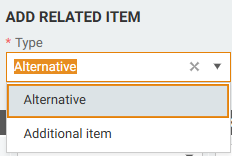
Additionally, the contract for relation type in Swagger is changed to enum for both file- import and file-export documentation.
Export to elastic based on promotion changes (RTC-46761)
When item gets an active promotion price, the data is exported with promotion sales price field to elastic. It happens when promotion is started, item is added to active promotion, planned promotion starts. Items removed from promotion or when promotion ends, are exported to elastic as documents without data on promotion price. If there is more than one promotion on item, one with current lowest promotion price is exported.
In item search API effective price is promotion price or ordinary price, depending on which is lower. Fields 'effectivePriceFrom' and 'effectivePriceTo' help filter result items. To search only promotion or only ordinary prices, there is boolean 'isInPromotion' to use in request body.
Add shelf locations texts to Store local values contract (RTP-36368)
Contract for importing and exporting store local values was extended with 'shelfArea' and 'shelfType' properties in 'shelfLocation' section. Each property contain 'code' and 'texts' with localized names. Existing 'shelfAreaCode' and 'shelfAreaType' are marked as obsolete and importing those fields does not make any changes to shelf locations on item. New properties work in import.
Remove export 'wholesale prices' (RTC-43632)
The 'Export prices to excel' button has been removed from the item list and Item segmentation, only 'export items to excel' is available. After clicking the button, the user is redirected directly to the export to excel view. Additionally, the 'export to excel' button in the item grid no longer has any options, and the ability to export wholesale prices has been completely removed.
Searching item by sales code (RTC-46637)
Sales code is an exported to elastic search properly. Adding, updating or removing sales code triggers export of item and changes are noted. It is searchable via API in 'fullTextQuery" field.
Edit only sales prices permission (RTC-43430)
New scoped permissions "Edit only sales prices" has been added. User with this permission can edit only sales price elements in the price calculation. Such user cannot create first ever price for a draft item. If there is no active price in the store (profile), an error "Could not find cost price for item" will be displayed. In a situation that user tries to change the price of the item for two stores at once, where one store has an active price and the other does not, an error message will be displayed. User with new permission can create a future price only if an active price already exists in the store.
Users with 'Create/edit prices' permissions can create and edit prices as before.
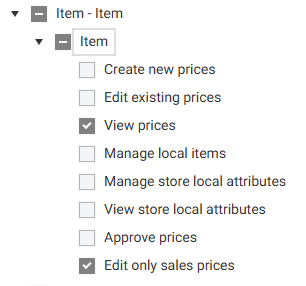
Food supplier (RTC-34916)
"Food production supplier" flag is added to the Supplier register. Column with this information is hidden by default but can be added to the grid from "+". Food Production Supplier flag can be Enabled/Disabled. The flag can be updated via Excel/JSON import and exported via Excel/JSON format.
Ingredients (RTC-46819)
Ingredients can be copied by using the button "Copy" hidden in the "..." option. Copied ingredient is automatically created with the same data as existed one and new ingredient no.
Fix: Creating an item with product features via RIGAL (RTC-46355)
It is now possible to create an item using the RIGAL file with a product feature. In the JSON file containing the product feature, the language code can be set as empty quotation "" marks. The file will be imported with the default country language.
At least one localization is required on item.
When importing a JSON file, item name must be present for the Language code. The model name should also be specified for at least one localization. When creating a new item, If the model name is missing in the JSON , it will be taken from the item name. A localization cannot exist without item text, label text1 or item receipt text. If these values are not present in the JSON, they will be taken from the item name.
All properties in the localized text can be edited. If they are not present in the JSON, those fields will not be changed. If the properties have values, they will be added or updated accordingly. If the properties have a null or empty string, those fields will be deleted. However, when such values ("null",empty string) are sent for the item name, the item name will be deleted only if the item has no additional properties, such as label text2, product features, advertise info or technical info. If these properties are present on the item, a validation error will occur.
The default country's language overrides the itemText (if it presents in the file) and will be applied to the item during import.
Fix: Filter deleted store prices in WholesalePricesChangesHandler in price suggestion job (RTC-47354)
PriceSuggestionProcessor is not failing and has the correct status with every execution (completed or completed with no effect). When there are deleted planned prices for profile level and new planned price is created, job processes only the not deleted price and updates 'children' prices accordingly with no duplicates. Additionally, created By for the 'child' store group's price is copied from the profile price, not from the active store price.
Fix: Shelf location is not editable (RTC-47392)
Shelf location number cannot be changed. It has been moved to the top and is now grayed out and non - editable.
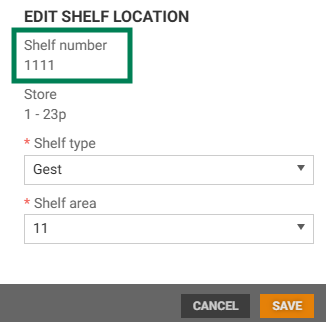
Fix: Item hierarchy export contains all values ((RTC-46923)
When Item hierarchy is exported, all values are retrieved, including numbers and names for all hierarchy types and filled languages.
Fix: Supplier is exported to 3rd party when the address is corrected RTC-46635
When changes are made to the supplier's address, the supplier is exported to the 3rd party with the correct address data.
Fix: Console error while opening modal to edit value in the register ((RTC-43548)
Error does not appear when opening the edit modal in the item registers.
Item/GetItemsByItemIdentifiers API RTC-47295
FIX: Endpoint now works correctly instead of returning 404 NOT FOUND.
Fix: Search indexing timeout (RTC-47426
Export of item changes to elastic search is much faster an does not cause timeout of SearchIndexing job.
Fix: Add support for cancelling SearchIndexing job ((RTC-47470)
More informative logs were added to SearchIndexing job, with information on amount of changes processed and documents sent to elastic. Additionally when execution of a job is cancelled, by for instant restart of integration package, job is resumed in correct place when package is up and running.
Return prices for given item (Contract) (RTC-46913)
A new contract for an API request has been added in Swagger, which will return prices for a given item. It is a POST api/gateway/Items/GetOrdinaryPrices request. The request body must contain the required parameters: ItemIdentifier, StoreNumber and 'activeOnUtc' (datetimeoffset).
Released 5th of February 2025
Import from 3rd party store local GTINs on items (RTC-43898)
A GTIN can be imported from 3rd party on item by specifying the store identifier and setting attemptToSaveAsCommon flag to True or False in alternative GTINs section. If the flag is set to False, the GTIN will be imported on store level as a store local GTIN. The same GTIN can exist for different items and different stores, as well as being a common GTIN for one item and a store local GTIN for other items. If the imported GTIN exists on different item within the same store, it will be 'stolen' by the imported item.
When the flag is set to True, and the GTIN does not exist on another item or exists on store level, the GTIN will be added on common level. If it exists on common level, the GTIN will be added as store local GTIN for the imported item.
It is not possible to set store local GTIN as the main GTIN. If isMain flag set to True and a store identifier is provided, an error message will be displayed. When creating a new item, only common GTINs are considered. If the GTIN sent in the file exists on the store level, it will not be found, and a new item will be created instead.
Display and export to 3rd party (RTC-43897)
GTINs added per store are supported and GTIN table in database is extended with store identifier. In Item details, manage GTINs view there are visible GTINs that are added per store on item. Store related columns are added to the grid and it is possible to filter on them. Contract to export local GTINs to 3rd party in Gateway.ItemChanges blobs is extended and store identifier is added to GTINs section.
It is possible to have the same GTIN set per different items and different stores, as well as the same GTIN set as no local GTIN on one item and local GTIN on other item.
Shelf label 4 (RTC-45327)
Shelf label 4 can be assigned to items and printed. Triggers to create a new label are changes in label text, advertisement info, sales code and price or Promotion price. Label can be printed manually from Item detail/ Item lists or added to Label list. On the label there is QR code generated from system parameter.
Look of the label:
On top of the label there is label text 1, beneath it advertisement info and overlapping texts are cut. Below there is sales code, price per unit and information if price is a Promotion price. In top right corner there is main shelf location. Price is located at the bottom left and is displayed differently for different countries of stores (currency and pennies). Price is highlighted to yellow when there is sales purpose field filled out, as when item is in Promotion without that field it is written in red font. In left bottom corner there is QR code.
Languages of the texts on label are based on store from which label is generated.
Fix: Adding shelf location does not trigger export to 3rd party (RTC-47063)
When adding or updating shelf location on item, blob Item.ItemStoreOverride.Export is triggered to export and contains correct data. It is exported both when there were no previous stor local values on item and if there were already.
Fix: Look of the grid and warnings (RTC-46253)
When an existing shelf location is assigned to an imported item, and shelf area and/or shelf type are not provided in the file, there is no warning displayed to the user. However, when creating a new shelf location, if the shelf area and/or shelf type are not provided in the Excel file, a warning will be displayed.
In the shelf locations grid, the first column with plus is fitted to icons width.
Extend exchange rate precision (RTC-46905)
It is possible to create or update currency rates with values with up to 6 decimals. Exchange rates can be created both via UI and import. When adding rated via UI there is validation allowing only 6 decimals, while via import values longer than 6 decimal will be cut and rounded to 6 decimals, correctly saved in database and exported to 3rd party.
Released 23th of January 2025
Text in confirmation dialog in Export view (RTC-46127)
When exporting entities other than item, the header and text inside the confirmation dialog are changed according to the exported values. The text on the button and Export page title is "export" instead of "Export item". Also the names of the entities in the left menu change according to the selected language.
Export image to elastic (RTC-45693)
Image Uri is exported to elastic search in the "thumbnailUri" field. Exported value is the image with the thumbnail role or if there is no role then the first image saved on the item will be exported.
Export image Url’s (RTC-45177)
Image Url’s are exported with the role to the gateway.itemchanges blob type. Images are exported with the same order as in the import file.
Fix: Exception when merging duplicated items between models (RTP-35403)
When moving items between models in import, if duplicated items are moved - on result model there already exists item with same same color/size, items are merged into one and last imported GTIN becomes main GTIN, rest is alternative. The same happens when similar items are moved from multiple models or are created via import.
New index in elastic (RTC-43832)
Items, which are connected to store via item-store link are exported as documents to Elastic Search. One document is an item per store. Items in elastic are updated whenever item changes or ordinary price is updated. Changes of price affect only document regarding relevant store group, while changes on item affect all stores item is active in. Creating price on higher store group level, such as profile or price zone will result in exporting as many documents as there are stores (on condition that item-store links are added). Removing item-store link results in removing document from elastic. When future price becomes active, price in elastic is updated accordingly.
New search API (RTC-43022)
A new search API /api/gateway/Search/items used to filter items is added along with a contract that allows the user to search by the fields placed in them. All the necessary information about the available fields and their operation is presented in the swagger contract schema.
Shelf locations assigned to item (RTC-42790)
In user interface, in Item details there is a new section called 'Shelf location' where assigned shelf locations are displayed. User can enter Manage shelf locations view by clicking on accordingly named button. In this view, it is possible to add shelf locations to item, by selecting correct shelf location in the 'Add panel'. Required fields are store and shelf location, but for the shelf location dropdown to be visible, store must be selected first. User can set shelf location as main and delete them from item. When deleting main shelf location, if there is any other shelf location for the same store, it will be set as main. Actions and visibility of data is limited by 'Manage' and 'View store local attributes' permissions.
Manage item in shelf locations (RTC-45394)
The user can enter the shelf location where the items assigned to it are displayed. Using the Add panel located at the top of the view, it is possible to add an item to the shelf location in which the user is currently located. To do this, just search for the item and after selecting it, it is automatically added. It is possible to remove an item from a shelf location using the option located in the line with the item, or to remove all items from a given shelf location using the option located in the lower right corner of the view. Before deleting all items a warning message is displayed, which the user can confirm or cancel the action. The other shelf numbers column contains the numbers of shelf locations to which the item is assigned within one store. Many additional numbers can be displayed as a comma-separated list. It is not possible to filter this column.
Fix for: Inactive stores are not available in active store assortment (RTC-45505)
If the store is inactive, it is not available in the dropdown when adding items to the active assortment.
Store local values API (RTC-31805)
There is a new API request which returns store local values. The request body must include a store identifier (storeNumber) and an item identifier (itemIdentifier - GTIN). It is possible to send multiple items in the request by placing identifiers in separate brackets and separating them with comma, but there can be only one store in request. In the response, there will be present data on all items matching identifiers. If there is no match for sent item identifier, then values are presented as empty square brackets.

'Values per profile' system parameter (RTC-46076)
A new system parameter has been added to the "Other settings" section regarding values per profile. There is a question displayed "Would you like to define warranty type and ID requirement per profile?". It is possible to set the value to true/false using the checkbox. By default, it set to False.


